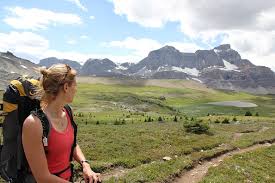skoki backpack

What's NewVisitor InformationActivitiesLearning ExperiencesNatural Wonders & Cultural TreasuresPark ManagementContact Us Important BulletinsClosures and RestrictionsTrail ReportRoad ReportConstruction ProjectsAvalanche ForecastBear Updates © L. Holleman When to Go | Where to Go | What to BringPasses, Permits & Reservations | Safety & StewardshipTrail Report | Warnings and Closures | Backcountry Campground Vacancy Report The main hiking season in Banff National Park is from May to October. Until late June, many trails at higher elevations remain snow-bound. Stream flows are highest during June and July; more remote trails have few bridges and require stream fording. July and August are the prime backcountry hiking months, although even in summer snow is not uncommon at higher elevations. September is generally drier than July and August, although temperatures are lower and there is a greater chance of snowfall. Regardless of the season, the weather in Banff National Park is unpredictable.

Being prepared for rain, snow or high winds at any time of year is especially important in the backcountry. Most visitors to the backcountry of Banff National Park are hikers. Travel by horseback or bicycle is also possible on designated trails. To see a map of Banff’s backcountry trails and campground locations, use the Backcountry Trails in Banff National Park brochure and see Suggested Itineraries to help you plan the best trip for you and your group. Backcountry campgrounds In more popular and accessible areas of Banff’s backcountry, you will find maintained hiking trails, designated campsites with outhouses, tent pads, food storage cables, picnic tables and metal fire rings (where fires are allowed). In more remote areas of the park, be prepared for fewer maintained trails and to be more self-reliant. Pre-trip planning and preparedness essential for travel in the backcountry. Rustic trail shelters Rustic Trail shelters located at Egypt Lake and Bryant Creek can be booked through the Parks Canada Visitor Centres in Banff or Lake Louise.

They can be booked in the same way as campsites with an added surcharge of $6.80/person/night. Dogs are not permitted in backcountry shelters.Alpine huts Alpine huts maintained by the Alpine Club of Canada are available to club members and non-club members. For information and reservations visit the Alpine Club of Canada. Commercial lodges There are four commercial lodges located in the backcountry of Banff National Park. Shadow Lake LodgeSkoki LodgeSundance LodgeHalfway Lodge Continuing beyond park boundaries?
ezvid best backpackFind out more about backpacking in areas connected to Banff National Park.
keep ahead backpack 40lJasper National ParkYoho National ParkKootenay National ParkAlberta Parks and Protected Areas - Kananaskis Country B.C. Provincial Parks
sniper backpack 8fields
Text and Photography by Mike Potter Skoki Valley is a great backcountry trip, providing some truly unique views of Banff National Park, (just look at the photo to the right) and is a good place to get off the beaten path in the Canadian Rockies and see some wildlife. This trail from Boulder Pass along the north shore of Ptarmigan Lake and over Deception Pass is the usual approach to Skoki Valley. (The trip from the Fish Creek parking area to Deception Pass and return can be made in a long day.)
alpinestars segment backpack Gordon Stermann, a long time Banff resident, and owner of local guide company White Mountain Adventures, is a big fan of this hike.
tf2 backpack ios “I love going in to Skoki in both summer and winter,” he says.
backpack electrofisher rental
“The route in has a tremendous variety of scenery, relatively few hikers, and is for the most part, at or above treeline. I can’t think of anything it lacks.” Furthermore, he adds, “The Skoki Valley itself is a great base for other day hikes in summer or ski tours in winter” A total of 16 km of travel from the parking area brings you to the backcountry campground at Merlin Meadows (1.2 km past Skoki Lodge), which serves as an excellent base for exploring the vicinity. A highlight of the campground is observing the daily routine of mountain goats on the avalanche slopes and cliffs to the north from the picnic table at your site. Skoki Valley was named from a native word meaning “swamp” or “marsh,” which also applied to the hometown in Skokie, Illinois, of one of the leaders of the first party of mountaineers to venture into the valley in 1911. See Fish Creek parking lot to Boulder Pass Distance: 7.2 km (4.5 mi) – Boulder Pass to Merlin Meadows backcountry campground

Extension to day hike or backpack: 1 hour one way to Deception Pass; 2.5 – 3 hour one way to Merlin Meadows backcountry campground Elevation Gain: 145 m (475 ft) – Boulder Pass to Deception Pass Elevation Loss: 385 m (1260 ft) – Deception Pass to Merlin Meadows campground Maximum Elevation: 2485 m (8150 ft) 0.0 – Wooden sign at east end of Boulder Pass (elevation 2340 m). Keep left for Deception Pass and Skoki Valley (Redoubt Lake and Heather Ridge to right). 0.5 – Junction with off-trail scrambling route to Packer’s Pass from Ptarmigan Lake climbing to left; keep right along lakeshore for Deception Pass 1.9 – Sign at junction (2365 m). Turn left and begin steep climb (Baker Lake trail goes straight). 2.5 – Deception Pass (2485 m). Descend north side on steady grade toward Skoki Valley. 4.9 – Junction with well-travelled horse trail veering off to left after a creek crossing. Keep straight to avoid mud and a narrow canyon.Keep left for Skoki Valley (Red Deer Lakes trail to right).